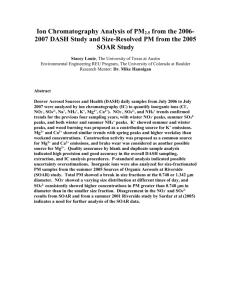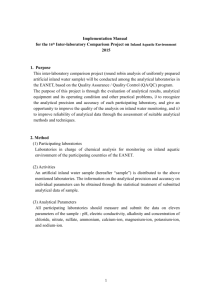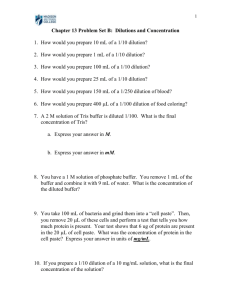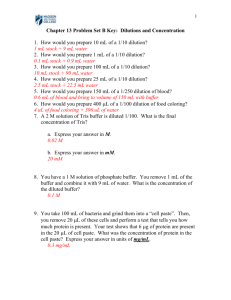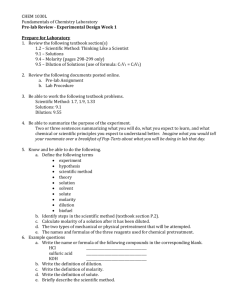2015Wet_Manual_Eng - Asia Center for Air Pollution Research(ACAP)
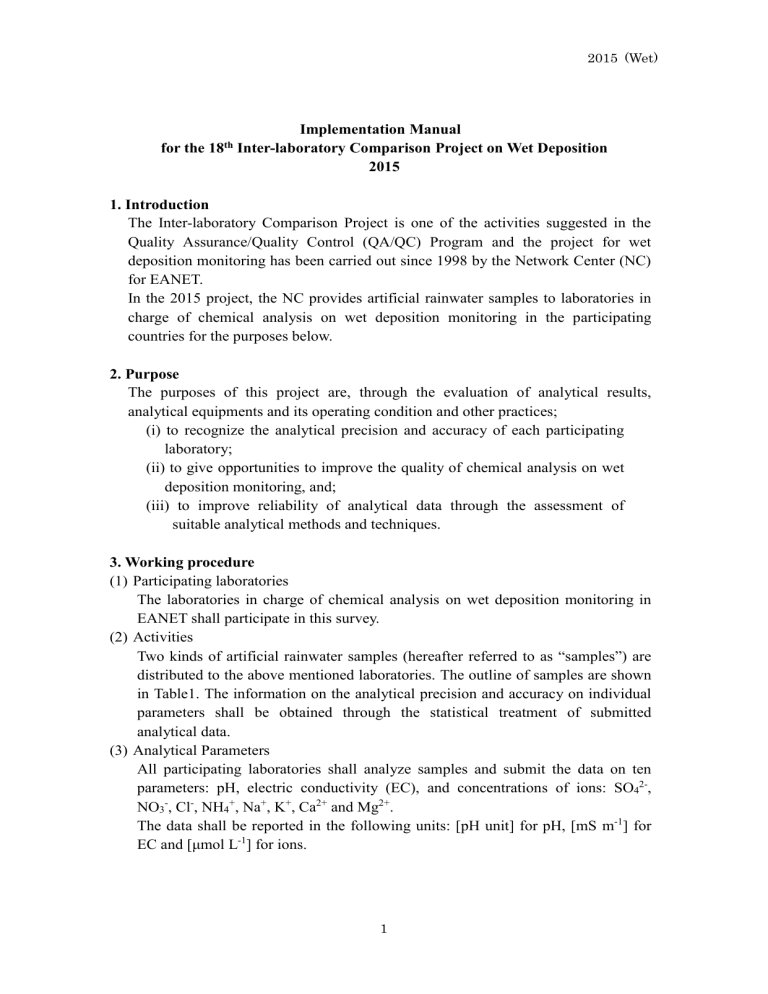
2015 (Wet)
Implementation Manual
for the 18 th Inter-laboratory Comparison Project on Wet Deposition
2015
1. Introduction
The Inter-laboratory Comparison Project is one of the activities suggested in the
Quality Assurance/Quality Control (QA/QC) Program and the project for wet deposition monitoring has been carried out since 1998 by the Network Center (NC) for EANET.
In the 2015 project, the NC provides artificial rainwater samples to laboratories in charge of chemical analysis on wet deposition monitoring in the participating countries for the purposes below.
2. Purpose
The purposes of this project are, through the evaluation of analytical results, analytical equipments and its operating condition and other practices;
(i) to recognize the analytical precision and accuracy of each participating laboratory;
(ii) to give opportunities to improve the quality of chemical analysis on wet deposition monitoring, and;
(iii) to improve reliability of analytical data through the assessment of suitable analytical methods and techniques.
3. Working procedure
(1) Participating laboratories
The laboratories in charge of chemical analysis on wet deposition monitoring in
EANET shall participate in this survey.
(2) Activities
Two kinds of artificial rainwater samples (hereafter referred to as “samples”) are distributed to the above mentioned laboratories. The outline of samples are shown in Table1. The information on the analytical precision and accuracy on individual parameters shall be obtained through the statistical treatment of submitted analytical data.
(3) Analytical Parameters
All participating laboratories shall analyze samples and submit the data on ten parameters: pH, electric conductivity (EC), and concentrations of ions: SO
4
2-
,
NO
3
-
, Cl
-
, NH
4
+
, Na
+
, K
+
, Ca
2+
and Mg
2+
.
The data shall be reported in the following units: [pH unit] for pH, [mS m
-1
] for
EC and [μmol L
-1
] for ions.
1
2015 (Wet)
4. Artificial rainwater samples for the survey
Artificial rainwater sample
No. 151w
No. 152w
Table 1. Outline of artificial rainwater samples
Volume of sample
Container
Number of sample
100ml each
Polyethylene bottle 100ml
One
Bottle
Each
Note
- Known quantities of reagents are dissolved in deionized water
- Samples do not include other ions other than shown in Table 2.
Before the measurement, the samples have to be diluted 100 times accurately with pure water in each laboratory according to the specified procedure. After dilution, the values of pH and each ion concentration should be within the range shown in the
Table 2.
Cl -
Table 2. Concentration range of the 100 times diluted samples
Parameter
H + as pH
SO
4
2-
NO
3
-
Range slightly acidic - neutral
5 – 100
mol L
-1
5 – 100
mol L
-1
5 – 100
mol L
-1
Parameter
NH
4
+
Na
+
K
+
Ca 2+
Mg
2+
Range
1 – 100
mol L
-1
1 – 100
mol L
-1
1 – 50
mol L
-1
1 – 50
mol L
-1
1 – 50
mol L
-1
5. Analysis
(1) Sample preparation and storage
Keep the samples in a cool and dark place such as a refrigerator after arrival.
Chemical analysis of the samples should be carried by the end of 2015.
Special attention should be paid to dilution of the samples, because the quality of sample could be changed by absorbing carbon dioxide and other air contaminant in the laboratory. With the same reason, the diluted samples should be analyzed immediately after dilution. Don’t keep the sample bottle open for hours.
(2) Dilution procedure a) Keep the samples and pure water for dilution in a laboratory for one to two hours until they become room temperature. Pure water used for dilution needs to be less than 0.15 mS m -1 of electric conductivity. b) Prepare three diluted samples for analysis from sample No. 151w. An example of sample dilution procedure is shown as follows:
(i) Wash a 1 L volumetric flask and its cap more than three times with pure water.
(ii) Fill approximately 80% of the volumetric flask from (i) with pure water.
2
2015 (Wet)
(iii) Take 10mL of sample No. 151w using a volumetric pipette and transfer to the volumetric flask from (ii). Add pure water up to the marked line of the flask to 1 L. After mixing well, put the diluted sample into a clean 1 L polyethylene bottle.
(iv) Using the same sample, repeat steps (i) to (iii) of the procedure two times to prepare the three diluted samples (a, b and c). c) Following the procedure b), prepare three diluted samples (d, e and f) of sample
No. 152w. d) Carry out the analysis of solution samples as soon as possible after drawing calibration curves. Analyze each diluted sample three times for individual parameters. e) Calculate the analytical data of the concentrations of the diluted samples. f) Analyze the pure water used for the dilution as well as the diluted samples.
(3) Analytical method
Use analytical methods and data check procedures for this inter-laboratory comparison survey as specified in the “Technical Manual for Wet Deposition
Monitoring in East Asia -2010, November 2010” (hereafter referred to as “Wet
Manual”). Analytical methods specified in the Wet Manual are shown in Table 3.
Parameter pH
Table 3. Analytical methods suggested for rainwater analysis
EC
SO
4
2-
, NO
3
-
,
Cl
-
NH
4
+
Na
+
, K
+
,
Ca
2+
, Mg
2+
Glass electrode
Conductivity cell
Analytical method
Ion chromatography, Spectrophotometry
Ion chromatography, Spectrophotometry (Indophenol blue)
Ion chromatography,
Atomic absorption /emission spectrometry
(4) Calibration
Calibration curves should be prepared from at least 5 level of standard solutions.
Be sure to confirm that the ranges of calibration curves cover the concentrations of the samples. After drawing calibration curves, an accuracy check by analyzing
Reference Materials (RMs) such as the samples for last inter-laboratory comparison survey is recommended.
(5)
“Detection Limit” and “Determination Limit”
In the process of determining the Detection Limit and Determination Limit for the suggested methods (Ion chromatography, Spectrophotometry, Atomic absorption/emission spectrometry) used for the chemical analysis of ions in the samples, a standard solution with concentration near the lowest determination limit (Std1) should be measured 5 times. The Detection Limits and Determination
3
2015 (Wet)
Limits are calculated from standard deviation (s.d.) as follows:
Detection Limit = 3 (s.d.) [μmol L -1 ]
Determination Limit = 10 (s.d.) [μmol L
-1
]
6. Preparation of the report
The report format is available from the following URL.
URL : http://www.acap.asia/~interlab/os/index.html
Complete the Report (1) to (14), in accordance with the following points. a) Report (1)
Enter the information of “Country”, “Organization”, “Contact person”, “TEL”,
“FAX” and “E-mail” in the cells colored blue.
The data in Report (1) are shown in relative cells automatically, based on the values in Report (4) to (13).
If the calculated R
1
and R
2
exceed the criteria shown in the Wet Manual, the dataset should be doubted and reanalysis should be carried out. b) Report (2)
Enter the concentrations of ions in standard solutions which used for calibration in the cells colored blue.
The concentration values need to be rounded to the 2nd decimal places.
The information of “Organization/Contact person” is shown in relative cells automatically based on the information in Report (1). c) Report (3)
Enter the analytical values obtained from 5 times repeat analysis of standard solution “Std1” in the cells colored blue.
The values need to be rounded to the 2nd decimal places.
The information of “Organization/Contact person” is shown in relative cells automatically based on the information in Report (1). d) Report (4) to (13)
Please be aware that the sheet of NH
4
+
is moved from Report (13) to Report (9) according to the order of ions written in Wet Manual.
(i) Enter the name of the person who analyzed the sample in the cell of “Person in charge of measurement”.
In the case that several persons carry out the measurement, enter the name of the person who mainly carried out the analysis.
(ii) Enter the years of experience on chemical analysis and chemical analysis of acid deposition for the person in charge of rain water analysis, in the cell of
“Years of experience for chemical analysis” and “Years of experience for chemical analysis of acid deposition”, respectively.
(iii) Enter the date when the dilution procedure is carried out in the cell of “Start date of analysis”, and enter the date when the measurement of individual
4
2015 (Wet) parameter in samples is completed in the cell of “Finish date of analysis”.
The date need to be entered as “Year/Month/Day”. (e.g. 2013/10/31)
(iv) Enter the analytical value of pure water used for the dilution of samples in the cell of “(parameter) of/in pure water”. If the value is below the detection limit, enter “< detection limit value” in the cell. (e.g. <0.3)
(v) Enter the serial number of distributed samples in the cell of “Serial Number”.
The number is printed on the label of bottle. (e.g. 007)
(vi) Enter the analytical values of the diluted sample in the cell of “Data” as following digit. (The “Average” is calculated automatically.)
pH and EC: to the 2nd decimal place after rounding the 3rd decimal number
(e.g. If the value is “4.712”, enter “4.71” in the cell)
Concentrations: to the 1st decimal place after rounding the 2nd decimal number
(e.g. If the value is “54.38”, enter “54.4” in the cell)
(vii) Enter the information on “Measurement conditions” and “Calibration for measurement” of individual parameter in relative cells.
As to yellow colored cells, click the cell and select the number from the list appeared. e) Report (14)
Enter the information on QA/QC in the laboratory. In the cells colored blue, write the information. In the checkboxes colored blue, choose your situation and check a checkbox. f) Graph & Chart
Append copies of calibration curves and analysis charts of Std1, pure water and
Sample No. 151w and 152w on the sheet “Graph & Chart”.
7. Submission of the report
Submission materials are as follows. a) Summary of results ----- Report (1) by Electronic file (MS Excel spread sheet) b) Concentration of standard solution ----- Report (2) by Electronic file (MS Excel spread sheet) c) Lowest determination limit ----- Report (3) by Electronic file (MS Excel spread sheet) d) Reports of parameters ----- Report (4) to (13) pH, EC, SO
4
2-
, NO
3
-
, Cl
-
, NH
4
+
, Na
+
, K
+
, Ca
2+
, Mg
2+ by Electronic file (MS Excel spread sheet) e) Information on QA/QC in the laboratory ----- Report (14) by Electronic file (MS Excel spread sheet) f) Copies of calibration curves for ions
SO
4
2, NO
3
, Cl , NH
4
+ , Na + , K + , Ca 2+ , Mg 2+
5
2015 (Wet) by Electronic file (JPEG, PDF, figure pasted on Excel, etc.) g) Copies of analysis charts for Std1
SO
4
2, NO
3
, Cl , NH
4
+ , Na + , K + , Ca 2+ , Mg 2+ by Electronic file (JPEG, PDF, figure pasted on Excel, etc.) h) Copies of analysis charts for pure water (blank)
SO
4
2-
, NO
3
-
, Cl
-
, NH
4
+
, Na
+
, K
+
, Ca
2+
, Mg
2+ by Electronic file (JPEG, PDF, figure pasted on Excel, etc.) i) Copies of analysis charts for the Sample No. 151w
SO
4
2-
, NO
3
-
, Cl
-
, NH
4
+
, Na
+
, K
+
, Ca
2+
, Mg
2+ by Electronic file (JPEG, PDF, figure pasted on Excel, etc.) j) Copies of analysis charts for the Sample No. 152w
SO
4
2-
, NO
3
-
, Cl
-
, NH
4
+
, Na
+
, K
+
, Ca
2+
, Mg
2+ by Electronic file (JPEG, PDF, figure pasted on Excel, etc.)
8. Deadline of Report Submission
February 29, 2016 (to be submitted to the NC through the QA/QC manager)
9. Address of Report Submission and Contact Person of the NC
Submit the reports to the Network Center through the National QA/QC manager of each participating country. Address of the NC is the following.
Please be aware that e-mail address was changed
Takashi Kaminoyama, Mr.
Ken Yamashita, Dr.
Data Management Department
Asia Center for Air Pollution Research (ACAP)
1182 Sowa, Nishi-ku, Niigata City, 950-2144 Japan
Tell: +81-25-263-0562
Fax: +81-25-263-0567
E-mail: datasubmit@acap.asia
6
